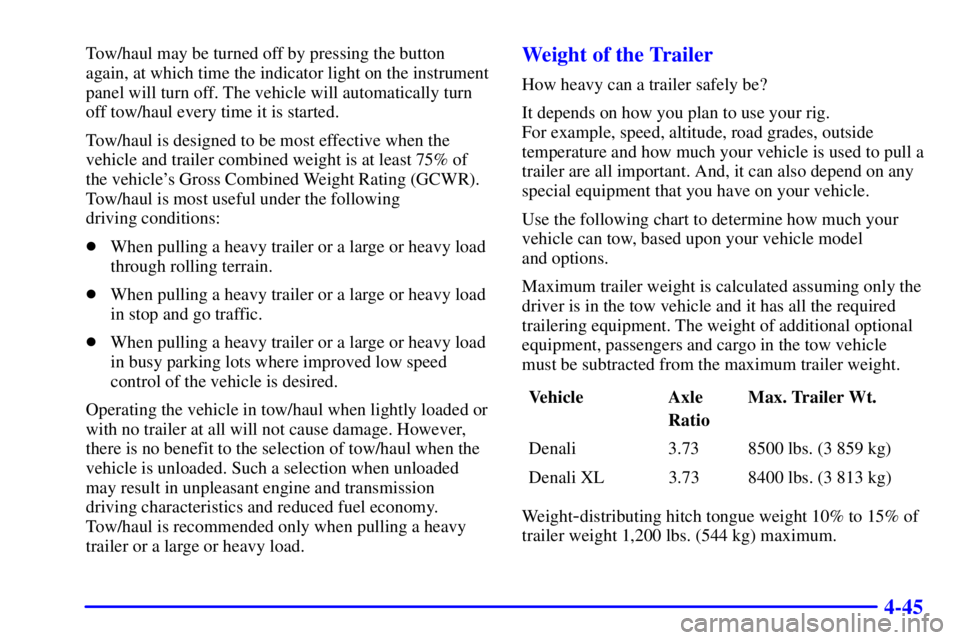Page 189 of 394

3-14
FADE: Press lightly on this knob to release it from its
stored position. Turn the control clockwise to adjust the
sound to the front speakers and counterclockwise for the
rear speakers. The middle position balances the sound
between the speakers.
Push these knobs back into their stored positions when
you're not using them.
Playing a Cassette Tape
Your tape player is built to work best with tapes that
are up to 30 to 45 minutes long on each side. Tapes
longer than that are so thin they may not work well in
this player.
To load a cassette tape with the ignition off, press
EJECT or RECALL. Then, insert the cassette tape.
If the ignition is on but the radio is off, the tape will
begin playing.
Once the tape is playing, use the VOL, BAL, FADE,
BASS and TREB controls just as you do for the radio.
The tape symbol and a direction arrow will be on the
display whenever a tape is being played. Anytime a
tape is inserted, the top side is selected for play first.
The player automatically senses if the cassette tape is
metal or CrO
2 and adjusts for best playback sound.PREV (1): Press the PREV button or the SEEK left
arrow to search for the previous selection. A minimum
three second blank gap is required for the player to stop
at the beginning of the selection. The tape direction
arrow will blink during the SEEK operation.
PROG (2): Press this button to switch from one side of
the tape to the other.
NEXT (3): Press the NEXT button or the SEEK right
arrow to search for the next selection. A minimum
three second blank gap is required for the player to stop
at the beginning of the selection. The tape direction
arrow will blink during the SEEK operation. The sound
will mute while searching for the next selection.
REV (4): Press this button to rapidly reverse the tape
to the beginning of the cassette or until you press REV
again. The radio will play the last selected station while
reversing the tape. The tape direction arrow will blink
during the reverse operation.
� (5): Press this button to reduce cassette tape noise.
The double
-D symbol will appear on the display while
the player is in this mode.
Dolby Noise Reduction is manufactured under a license
from Dolby Laboratories Licensing Corporation. Dolby
and the double
-D symbol are trademarks of Dolby
Laboratories Licensing Corporation.
Page 192 of 394

3-17
AM FM: Press this button to switch between AM, FM1
and FM2. If the front passengers are already listening to
AM FM, the RSA controller will not switch between the
bands and cannot change the frequency.
SEEK: While listening to AM FM, press the up arrow
to tune to the next higher station and stay there. Press
the down arrow to tune to the next lower station and stay
there. The sound will mute while seeking. The SEEK
button is inactive if the AM FM mode on the front radio
is in use.
While listening to a cassette tape, press the up arrow to
hear the next selection on the tape. Press the down arrow
to go back to the previous selection. The SEEK button is
inactive if the tape mode on the front radio is in use.
While listening to a CD, press the up arrow to hear the
next selection on the CD. Press the down arrow to go
back to the start of the current selection (if more than
eight seconds have played). The SEEK button is inactive
in the CD mode if the remote CD player or the
CD changer is in use.SCAN: Press and hold SEEK until the radio goes into
SCAN mode. SCAN allows you to listen to stations for
a few seconds. The receiver will continue to scan and
momentarily stop at each station until you press SEEK
again. The SCAN function is inactive if the AM FM
mode on the front radio is in use.
P.SET PROG: The front passengers must be
listening to something different for each of these
functions to work:
�Press this button to seek through the preset radio
stations set on the pushbuttons on the main radio.
�When a cassette tape is playing, press this button to
go to the other side of the tape.
�When a CD is playing in the CD changer, press this
button to select a disc.
TAPE CD: Press this button to switch between the tape,
remote CD and console
-mounted CD changer if all are
loaded. Press AM FM to return to the radio when a
cassette tape or CD is playing. The inactive tape or CD
will remain safely inside the radio for future listening.
Page 246 of 394

4-45
Tow/haul may be turned off by pressing the button
again, at which time the indicator light on the instrument
panel will turn off. The vehicle will automatically turn
off tow/haul every time it is started.
Tow/haul is designed to be most effective when the
vehicle and trailer combined weight is at least 75% of
the vehicle's Gross Combined Weight Rating (GCWR).
Tow/haul is most useful under the following
driving conditions:
�When pulling a heavy trailer or a large or heavy load
through rolling terrain.
�When pulling a heavy trailer or a large or heavy load
in stop and go traffic.
�When pulling a heavy trailer or a large or heavy load
in busy parking lots where improved low speed
control of the vehicle is desired.
Operating the vehicle in tow/haul when lightly loaded or
with no trailer at all will not cause damage. However,
there is no benefit to the selection of tow/haul when the
vehicle is unloaded. Such a selection when unloaded
may result in unpleasant engine and transmission
driving characteristics and reduced fuel economy.
Tow/haul is recommended only when pulling a heavy
trailer or a large or heavy load.Weight of the Trailer
How heavy can a trailer safely be?
It depends on how you plan to use your rig.
For example, speed, altitude, road grades, outside
temperature and how much your vehicle is used to pull a
trailer are all important. And, it can also depend on any
special equipment that you have on your vehicle.
Use the following chart to determine how much your
vehicle can tow, based upon your vehicle model
and options.
Maximum trailer weight is calculated assuming only the
driver is in the tow vehicle and it has all the required
trailering equipment. The weight of additional optional
equipment, passengers and cargo in the tow vehicle
must be subtracted from the maximum trailer weight.
Vehicle Axle
RatioMax. Trailer Wt.
Denali 3.73 8500 lbs. (3 859 kg)
Denali XL 3.73 8400 lbs. (3 813 kg)
Weight
-distributing hitch tongue weight 10% to 15% of
trailer weight 1,200 lbs. (544 kg) maximum.
Page 274 of 394

5-20
Denali XL Models
A. Bottle Jack
B. Wheel Blocks
C. Wing Nut
D. Mounting Bracket
E. Removable TrayF. Retaining Hook
G. Retaining Bracket
and Wing Nut
H. Tool Kit with Jack
Tools and GlovesDenali: The equipment you'll need is located under the
second row passenger's seat on the driver's side of the
vehicle, and behind the left trim panel on the driver's
side of the vehicle. Skip the first step and follow the
last three.
Denali XL: The equipment you'll need is located
under the storage tray in the rear trim panel on the
driver's side of the vehicle.
1. Remove the tray to access the tools.
2. There is a wing nut used to retain the tool kit.
To remove it, turn the wing nut counterclockwise.
3. To release the bottle jack from its holder, turn
the knob on the bottle jack counterclockwise
to lower the jack head.
4. The wheel blocks and the wheel block
retainer can be removed by turning the
wing nut counterclockwise.
You'll use the jack handle extensions and the wheel
wrench to remove the underbody
-mounted spare tire.
Page 285 of 394
5-31
Denali Models (Rear Access Panel)
A. Speaker
B. Bottle Jack
C. Wing Nut
D. Retaining Hook
E. Tire Blocks
F. Cover Panel1. Put the tool kit, with the jack tools and gloves, in the
tool bag and place in the retaining bracket under the
second row passenger's seat on the driver's side of
the vehicle.
2. Tighten down with the wing nut.
3. Then, assemble tire blocks (E) and bottle jack (B)
together with the wing nut and retaining hook (D).
4. Position behind the jack storage cover in the rear
side panel on the driver's side of the vehicle just
below the speaker (A) and tighten, adjusting
clockwise until the jack is secured tight in the
mounting bracket.
Page:
< prev 1-8 9-16 17-24